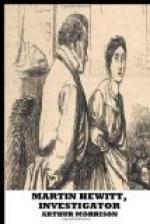“First, now, the apple was white. A bitten apple, as you must have observed, turns of a reddish brown color if left to stand long. Different kinds of apples brown with different rapidities, and the browning always begins at the core. This is one of the twenty thousand tiny things that few people take the trouble to notice, but which it is useful for a man in my position to know. A russet will brown quite quickly. The apple on the sideboard was, as near as I could tell, a Newtown pippin or other apple of that kind, which will brown at the core in from twenty minutes to half an hour, and in other parts in a quarter of an hour more. When we saw it, it was white, with barely a tinge of brown about the exposed core. Inference, somebody had been eating it fifteen or twenty minutes before, perhaps a little longer—an inference supported by the fact that it was only partly eaten.
“I examined that apple, and found it bore marks of very irregular teeth. While you were gone, I oiled it over, and, rushing down to my rooms, where I always have a little plaster of Paris handy for such work, took a mold of the part where the teeth had left the clearest marks. I then returned the apple to its place for the police to use if they thought fit. Looking at my mold, it was plain that the person who had bitten that apple had lost two teeth, one at top and one below, not exactly opposite, but nearly so. The other teeth, although they would appear to have been fairly sound, were irregular in size and line. Now, the dead man had, as I saw, a very excellent set of false teeth, regular and sharp, with none missing. Therefore it was plain that somebody else had been eating that apple. Do I make myself clear?”
“Quite! Go on!”
“There were other inferences to be made—slighter, but all pointing the same way. For instance, a man of Foggatt’s age does not, as a rule, munch an unpeeled apple like a school-boy. Inference, a young man, and healthy. Why I came to the conclusion that he was tall, active, a gymnast, and perhaps a sailor, I have already told you, when we examined the outside of Foggatt’s window. It was also pretty clear that robbery was not the motive, since nothing was disturbed, and that a friendly conversation had preceded the murder—witness the drinking and the eating of the apple. Whether or not the police noticed these things I can’t say. If they had had their best men on, they certainly would, I think; but the case, to a rough observer, looked so clearly one of accident or suicide that possibly they didn’t.
“As I said, after the inquest I was unable to devote any immediate time to the case, but I resolved to keep my eyes open. The man to look for was tall, young, strong and active, with a very irregular set of teeth, a tooth missing from the lower jaw just to the left of the center, and another from the upper jaw a little farther still toward the left. He might possibly be a person I had seen about the premises (I have a good memory for faces), or, of course, he possibly might not.




